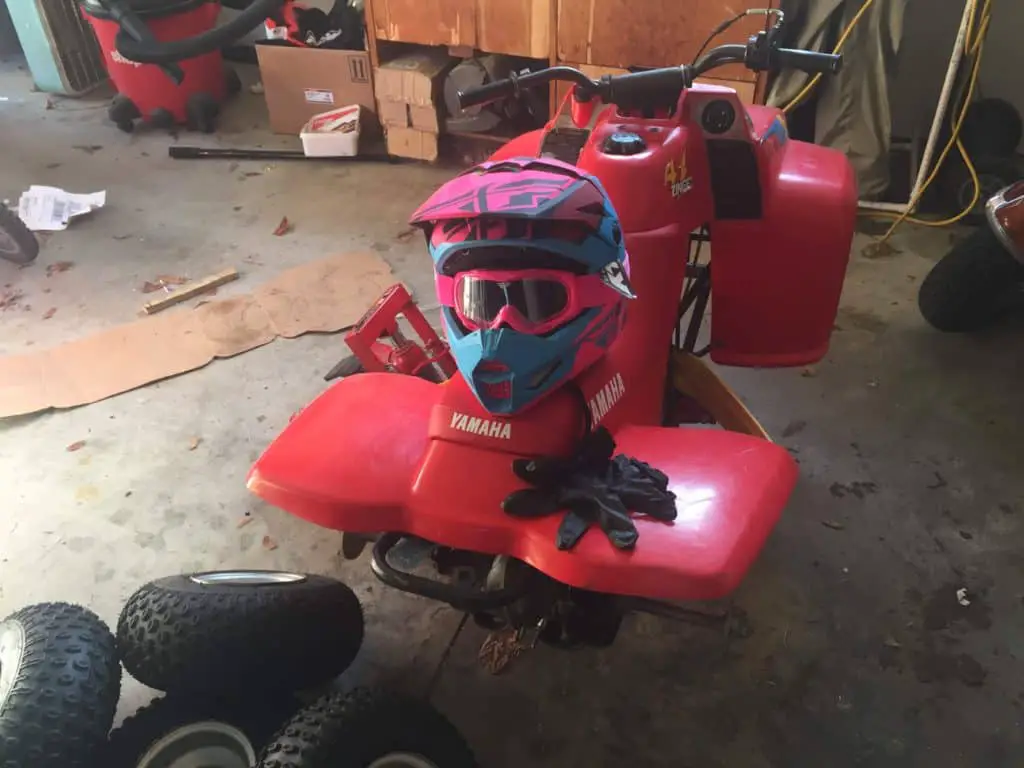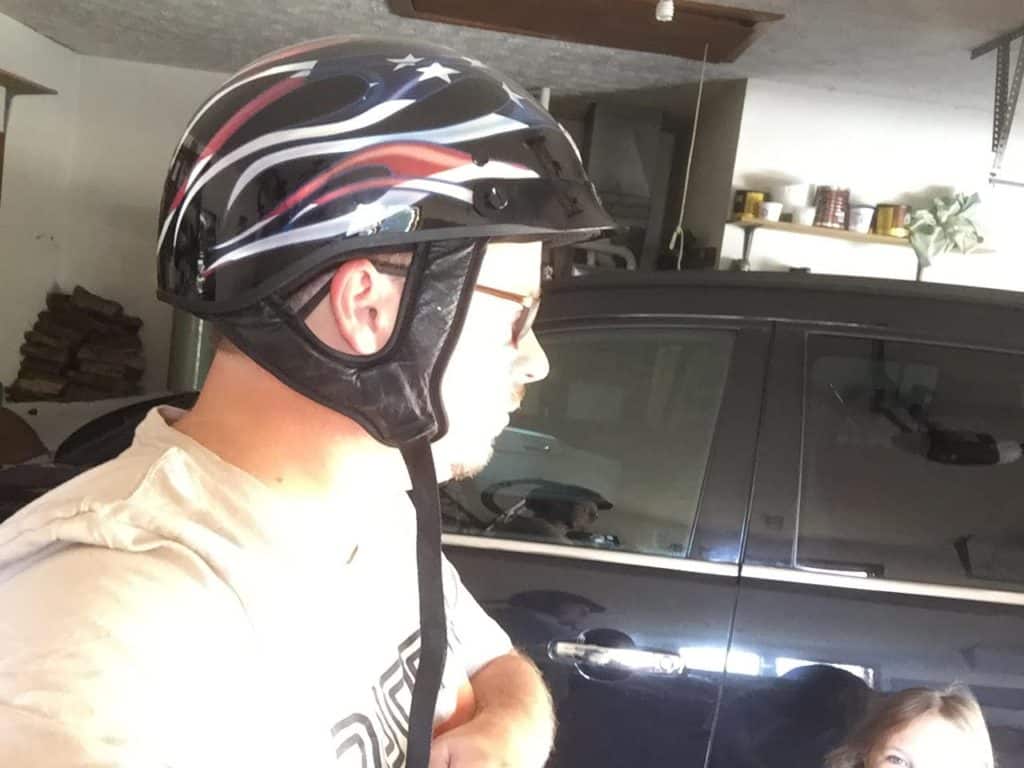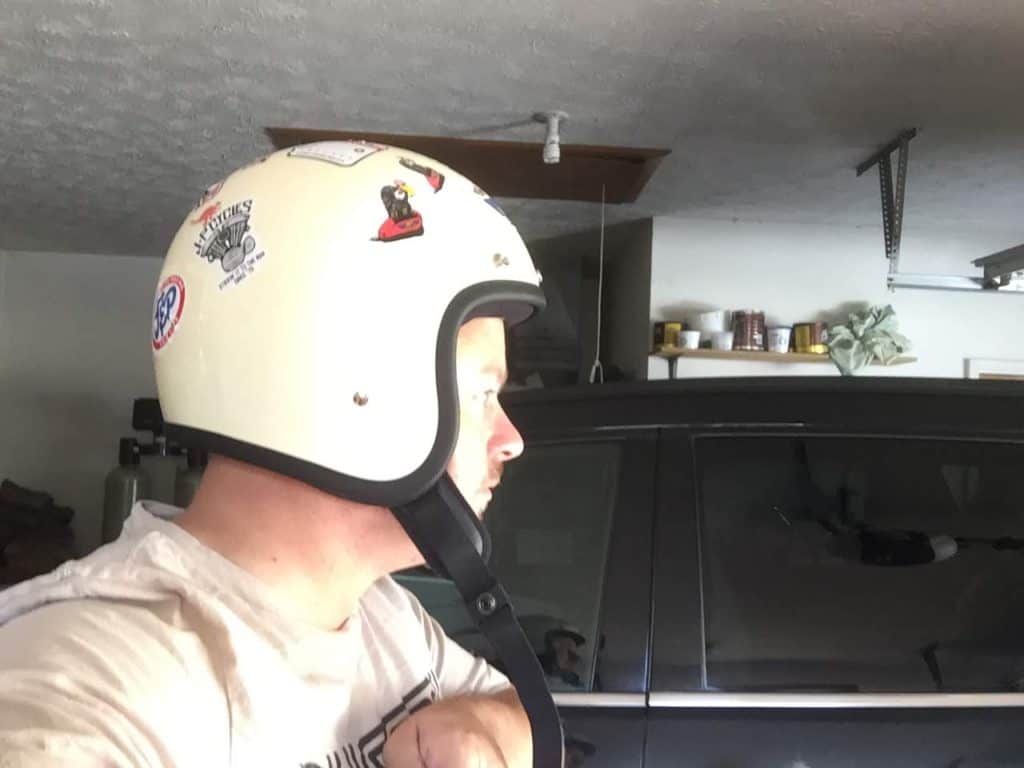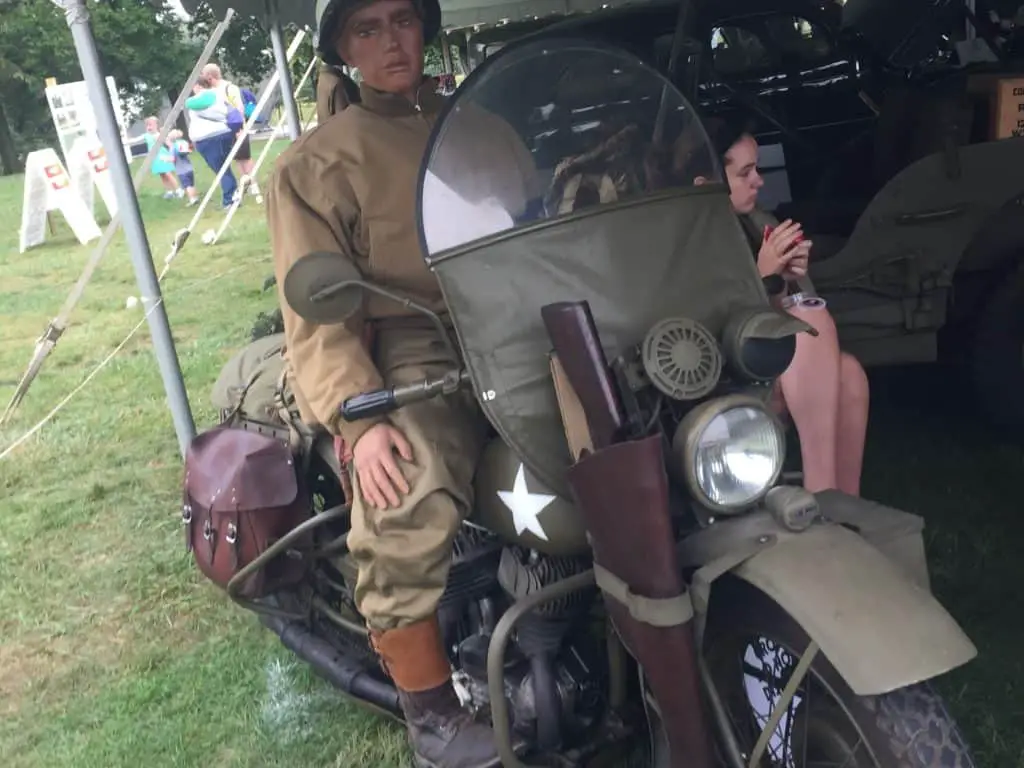I was in the garage the other day looking for something and noticed my two helmets sitting on the shelf. One is an older full-face helmet, and the second is a half helmet. I wondered about their safety, specifically the half helmet.
Is a motorcycle half helmet safe? No. Motorcycle half helmets do not provide the same level of safety as a full face helmet. When wearing a half helmet, you will need to wear other accessories to help protect other areas like your eyes and face.
To make the best and most confident decision on buying a half helmet, fully understand what and why you are buying the half helmet. There are many choices to make in selecting your helmet.
Differences Between Full Face and Half Helmet Safety
If you are not familiar with helmets, we should talk a little about the differences between a full face and half helmet. This will give a perspective on what it means to be “safe.”
Look at the pictures below and you quickly see a few differences between the helmets.


- The full face has a bridge that protects the cheeks, mouth, and nose area. The half helmet leaves these exposed to the natural elements as you ride.
- Upon the initial inspection, a newer rider would conclude the full faced provides a narrowed view when compared to the half face. The vision area on the full face is not as big.
- The half helmet leaves your ears exposed while a full face covers them. You may wonder if this affects your hearing. We will discuss this topic later in the post.
- There is a notable size difference between the two styles of helmets. The full faced takes up a lot of room for storage and can be a pain to “store” on the bike. A half helmet is easier to tuck away into a saddlebag.
- The size directly relates to protection of your whole head. The full faced as we discussed in point 1, protects your whole head. The half helmet literally only protects what I call the cranial cavity. This means it only covers the area of the head where the brain sits. You should quickly be able to understand why a full face provides better protection than a half helmet.
One reason people like motorcycles is for the freedom. Freedom of choice in helmets falls into this bucket. We do not limit riders to two kinds of helmets. Here is a third kind.
3/4 Helmet

We refer to the third helmet as an open face or three quarter helmet. It comes down the side of the head covering the ears and down the back of your head to the bottom of your cranium like a full faced.
The front will be open like the half helmet. I did not talk about this style of helmet as the protection and benefits are somewhere in between the full faced and half helmets.
Comparing Riding Conditions for Full Face and Half Helmets
Now we have discussed differences in the helmet styles, let’s talk about the what to expect while riding with each style of helmet.
While not scientific, I can provide perspective on the topic. I have both styles of helmets and enjoy the features of both.
Rain
The full-faced helmet is better when riding in the rain. If you have not ridden in the rain, you will experience the joy of what feels like BB’s hitting you in the face. Riding in a light rain with slow speeds does not make the H2O factor a big deal. I found that speeds above 30 mph favor a full-faced helmet over a half.
The one downfall to a full face comes into play when you have a cover over the field of vision. It can make seeing rather difficult. Riding becomes similar to driving a car without running your windshield wipers. This becomes unsafe.
To address this, I have seen people put RainX on their shields with mixed results. Riders also purchase gloves with a rubber blade on them. This allows riders to have a finger as a windshield wiper.
Riding with a half helmet means taking a pounding on our face while squinting. You know the squinting I am talking about. The kind when you turn 40 and while trying to read something small. This is even more unsafe than with a full-faced helmet and why most riders pull over under an overpass or into a gas station while it rains.
In fact, I would propose an informal experiment the next time you take a long trip. Look at how many people you see riding in the rain with full-faced helmets vs half helmets. When did they pull over and who kept going? If you remember, post your results in the comments below. It makes for an interesting conversation.
For the biker who hates helmets, a frequent comment is, “Yeah, but it does not rain that often, so I will ride with the half/No helmet anyway.” To which I reply, “That‘s fine and your choice, but I have big reasons to protect myself.” Namely, my family is my reason plus I know the consequences first hand of not wearing a helmet. We’ll discuss that another time.
How Cold Weather Affects Helmet Safety
Fall is my favorite time of year. It is also my favorite time to ride. In fact, every year for the past 16 years, I take a fall ride. Not a long one, but far enough to make my butt hurt.
In Indiana you never know what the weather will be like. The first year I had my Harley, my wife, and I ended up sitting in a traffic jam in 90 degree heat. We sat on an oven and sweat badly. For this ride, like a dummy, we did not wear helmets. (That has since changed, we will not get on the motorcycle without a helmet.) We made the mistake of not putting safety first because of the heat.
Four years ago, I had the coldest fall ride I had ever taken. It was in the mid-30s. For This ride, I wore my half helmet. For the first and only time I wore this while riding in temperatures below 55 degrees.
The ride in the mid-30s left my face numb. I could not feel my lips or ears kind of numb. I was wearing a thick winter hat that covered my ears, but to no avail the cold penetrated my head gear.
One of the more interesting aspects of that ride were the sensations around my neck. During all my cooler fall rides (in the 50s or below) I wear protection around my neck. With the full-faced helmet, I feel fine.
With the half helmet, after about 10 minutes, it feels like there is no protection. This makes sense after I reflect for a few moments. The wind buffers and flows around each helmet differently. There was not much thought around the aerodynamics of the helmets.
A few of the other full face helmets from my past have had similar airflow.
The point being, a half helmet is much colder on your face, ears, and neck than a full-faced helmet. The biggest danger riding in cold weather with a half helmet is frostbite. After your parts go numb, you don’t realize how cold it gets. I know this from riding dirt bikes as a kid in the winter. I was dealing with cold weather riding yesterday while teaching my daughter how to ride her new ATV. (I will discuss that another day.)
How Hot Weather Riding Affects Helmet Safety
After reading about the cold riding, you would assume the opposite to be true for warm weather riding. Mostly I would agree, but with a few surprises.
- A good full-faced helmet is not as hot as you think. Most of them have air vents above your eyes and below your chin. Make sure those are open. While closed in the heat, it gives you the Hades ride you would expect.
- Full faced, helmets are not as comfortable as half helmets.
- I would expect a helmet to become unbearable while sitting in slow moving traffic or a traffic jam. My personal experience has been mixed with full-faced helmets on this front. Half helmets are not as hot, but you run a higher chance of getting sunburn.
You can always put sunscreen on your face for protection. Don’t forget to protect those eyes.
Vision On a Half Helmet Versus A Full Helmet
One of my favor arguments for wearing a half helmet over the full faced is vision. To address this challenge, the fix is simple. GET A DIFFERENT HELMET!
You get vision problems when the helmet does not fit properly. When you have the correct full-faced lid, this no longer becomes a point in favoring a half-faced helmet.
Half Helmets: A Way To Rebel Without Rebelling
Many states require a helmet, and those bikers who are against the law but don’t want a ticket try go get by with the least about of participation as they can.
So they buy a half helmet. Rebelling for the sake of rebelling versus enjoying the riding experience for its own sake can only mean that a half helmet provides some protection while no helmet provides none.
Helmet Protection In An Accident
If you have not picked up by now, the full-faced helmet provides the most protection for your whole head while the half helmet mainly protects your brain casing.
As a motorcyclist, determine your own level of protection. I only ask that you give the topic a full evaluation. It only takes one mistake like not wearing a helmet to change the course of your life.
Helmet Weight Differences And How It Affects The Rider‘s Safety
This point is not as simple to test as I would have initially thought. With all the new materials that go into safety products, I have seen a few full-faced helmets weigh less than half helmets.
You should look at the weight of the helmet, as this will affect your riding. The longer the ride, the more strain it puts on your neck and head. When I have gone for longer rides with a new helmet or changing to a heavier helmet, my head hurts to the point a migraine will develop.

With the style of helmets I like and that are comfortable, half helmets allow me to ride further and without discomfort.
As a rider, you need to pay attention to how the weight of a helmet affects you. If you move to a heavier helmet, make sure you take extra stops or make your stops longer to prevent headaches. You may end up paying more attention to the pain versus riding and your surroundings.
Can You Hear Better With A Half Helmet?
While you can hear with a full-faced helmet, you can hear better with the half lid.
Here is a simple test to compare two helmets for hearing:
- Put on the lid.
- Have a friend stand 10-15 feet behind you and have them talk in a normal voice.
- Can you hear them? If not, have them move closer.
- Repeat the process with the second helmet.
- Compare the results. The winner will be the one with the person talking furthest away from you.
Related Questions:
How effective are motorcycle helmets? Helmets are about 67 percent effective in preventing brain injuries and 37 percent effective at preventing death. Yes, they are effective, but do not eliminate the risk of severe injury.
Are motorcycles that dangerous? Riding motorcycles is more dangerous than driving a car. This should not be a surprise considering the rider is in the open and moving at the speed of a car. A rider needs to weight the enjoyment and benefits of riding with the risks in the same way a parachuter, hunter, or bungee jumper does.
